Contents
- The Mystical Appeal: Tarot Reading in Pop Culture
- The Origins of Tarot Reading
- Tarot Reading in Movies and TV Shows
- Tarot Reading in Music
- Tarot Reading in Fashion and Art
- Tarot Reading in Literature
- Tarot Reading in Social Media
- Conclusion
-
Frequently Asked Questions
- 1. What is the purpose of tarot reading?
- 2. Is tarot reading a form of fortune-telling?
- 3. Can anyone learn to read tarot cards?
- 4. What is the significance of the Major Arcana in tarot reading?
- 5. Can tarot reading provide definitive answers?
- 6. Is tarot reading associated with any specific religious beliefs?
- 7. Can tarot cards reveal hidden secrets or information?
- 8. Are online tarot readings as accurate as in-person readings?
- 9. Can tarot cards be used for manifestation or setting intentions?
- 10. How can one find a reliable tarot reader?
- References
The Mystical Appeal: Tarot Reading in Pop Culture
The rise of tarot reading in pop culture has sparked intrigue and fascination among people from all walks of life. While this ancient practice has been around for centuries, its recent surge in popularity can be attributed to its portrayal in various forms of entertainment, such as movies, TV shows, and music. Tarot cards have become a symbol of mysticism, offering a glimpse into the unknown and providing a source of guidance and introspection. This article will explore the origins of tarot reading, its influence in movies and TV shows, its presence in music and fashion, its role in literature, and its impact on social media. Join us on a journey through the enchanting world of tarot as we delve into its intriguing presence in popular culture.
The Origins of Tarot Reading
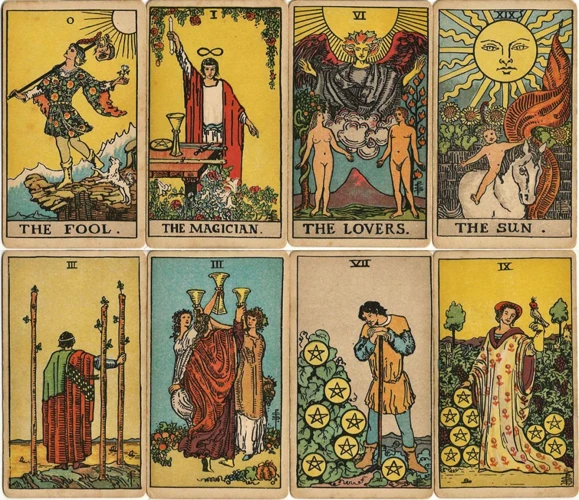
Tarot reading, with its enigmatic allure, can be traced back to the 15th century, when the first tarot decks were thought to have appeared in Europe. While the true origin of tarot cards is shrouded in mystery, they are believed to have emerged from a combination of various influences, including playing cards, religious symbolism, and ancient occult practices. Tarot decks generally consist of 78 cards divided into two main categories: the Major Arcana and the Minor Arcana. The Major Arcana represents significant life events and archetypal energies, while the Minor Arcana reflects the ups and downs of daily life. The use of tarot cards for divination and self-reflection gained popularity during the 18th and 19th centuries, especially among esoteric societies and mystics seeking spiritual insights. Today, tarot reading has transcended its historical roots and continues to evolve in the digital age, with online tarot readings and mobile applications becoming increasingly popular. The impact of tarot reading on modern witchcraft, as well as its influence on fashion trends, further demonstrates its enduring presence in our society.
Tarot Reading in Movies and TV Shows
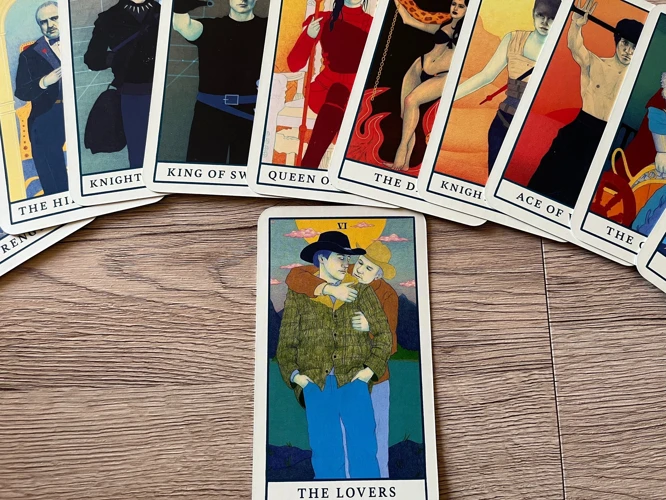
Tarot reading has found its way into the realm of movies and TV shows, adding an element of intrigue and mysticism to various storylines. It has become a powerful tool for filmmakers and scriptwriters to create captivating narratives, explore characters’ inner thoughts and motivations, and evoke a sense of otherworldliness. Tarot cards are often used in two distinct ways within the realm of visual media:
1. The Influence of Tarot on Plotlines: Tarot reading is occasionally integrated into the plotlines of movies and TV shows. It serves as a catalyst for events, offering prophecies or guiding characters on their journeys. For example, in the popular TV series “Penny Dreadful,” tarot cards are utilized to foretell the fate of the characters, shaping the narrative and introducing supernatural elements into the storyline.
2. Tarot Cards as Character Features: Tarot cards are also frequently employed as symbolism to represent certain characters’ traits or journeys. The specific cards chosen for a character can provide insight into their personality, desires, or even foreshadow their storyline. In “The Magicians” book series and subsequent TV adaptation, each character possesses a personalized set of tarot cards that reflect their unique magical abilities and personal growth throughout the story.
These cinematic and television portrayals have helped to popularize tarot reading, captivating audiences with its mystical allure and encouraging further exploration of this ancient practice. Tarot’s appearances in movies and TV shows bring the centuries-old tradition into the modern entertainment landscape, showcasing its enduring relevance and making it more accessible to a wider audience.
1. The Influence of Tarot on Plotlines
The influence of tarot on plotlines within movies and TV shows is a testament to its captivating mysticism. Tarot cards have been seamlessly integrated into the narratives of various films and television series, adding an element of intrigue and symbolism. In some cases, tarot reading is used as a plot device, driving the story forward and providing key insights into character motivations and future events. Films like “Live and Let Die” and “The Craft” incorporate tarot reading as a means to foreshadow impending danger or reveal hidden truths. TV shows such as “Penny Dreadful” and “American Horror Story: Coven” explore the darker aspects of tarot, diving into the realms of horror and witchcraft. The rich imagery and archetypal meanings of the tarot cards amplify the tension and mystery within these narratives. Tarot’s inclusion in plotlines serves to blur the lines between reality and the supernatural, creating a compelling viewing experience for audiences. It also encourages viewers to delve deeper into the world of tarot, further fueling its popularity in the /influence-tarot-fashion-trends/ realm of pop culture.
2. Tarot Cards as Character Features
Tarot cards have not only found their way into the plots of movies and TV shows but have also become an integral part of character development. The presence of tarot cards as character features adds depth and complexity to the storytelling. These cards often serve as symbolic tools that reflect and enhance the personalities, desires, and struggles of the characters. For example, in the popular TV series “American Horror Story: Coven,” the character of Fiona Goode, portrayed by Jessica Lange, is depicted as a powerful witch who frequently consults tarot cards to guide her decisions. The tarot cards she holds in her hand represent her desire for control and her manipulation of fate. Similarly, in the movie “The Magicians,” based on the book series by Lev Grossman, the character of Quentin Coldwater, played by Jason Ralph, discovers his magical abilities through a tarot reading, setting off a chain of events that lead him on a journey of self-discovery and adventure. Tarot cards as character features not only add an element of mysticism and intrigue but also serve as a visual representation of the character’s internal struggles and desires. As the evolution of tarot reading continues in the digital age, it will be interesting to see how tarot cards are portrayed and utilized as character features in future movies and TV shows, further emphasizing the enduring influence of tarot reading in modern witchcraft.
Tarot Reading in Music
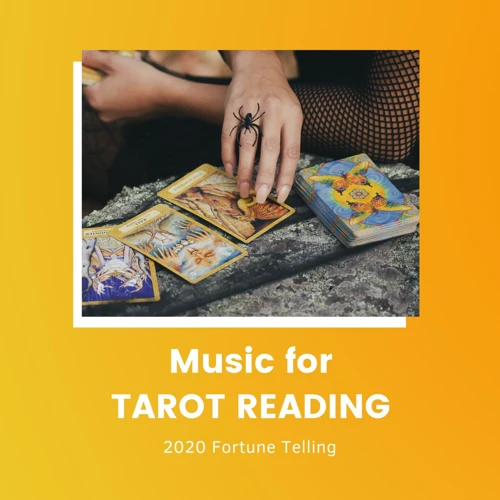
1. Lyrics and Symbolism
In the realm of music, tarot reading has found its place in lyrics and symbolism, adding an element of mysticism and depth to songs. Many artists draw inspiration from the rich imagery and meanings associated with tarot cards. The lyrics often incorporate references to specific cards, such as “The High Priestess,” “The Fool,” or “The Tower,” to evoke certain emotions or convey a deeper message. These references may offer insights into personal struggles, spiritual journeys, or philosophical concepts. Symbolism related to tarot reading can also be found in the melodies, harmonies, and overall musical composition. Songs infused with tarot symbolism create an atmospheric experience for listeners, inviting them to explore hidden meanings and embark on a mental journey. The fusion of tarot reading with music demonstrates how this ancient practice resonates with artists and their audiences by tapping into universal themes and human experiences. The evolution of tarot reading in the digital age has prompted musicians to explore new ways of incorporating tarot symbolism into their work, blending tradition with modernity. The impact of tarot reading on modern witchcraft has also influenced musicians who align themselves with the occult and pagan ideologies, resulting in music that reflects their beliefs and practices.
2. Album Artwork
In the realm of music, tarot reading has also found its place in album artwork, adding a touch of mysticism and intrigue to various musical genres. Artists often incorporate tarot symbolism into their album covers, creating visually captivating designs that reflect the themes and emotions conveyed in their music. The use of tarot cards in album artwork allows musicians to tap into the mystical and introspective nature of tarot reading, enhancing the overall artistic experience for listeners. These album covers may feature striking visuals of tarot cards, such as The Fool, The High Priestess, or The Lovers, each representing different aspects of life and human emotion. They add depth and symbolism to the music, inviting listeners to explore the hidden meanings within the songs and connecting on a deeper level. This integration of tarot imagery in album artwork creates a powerful union of visual and auditory elements, making the overall musical experience even more immersive.
Tarot Reading in Fashion and Art
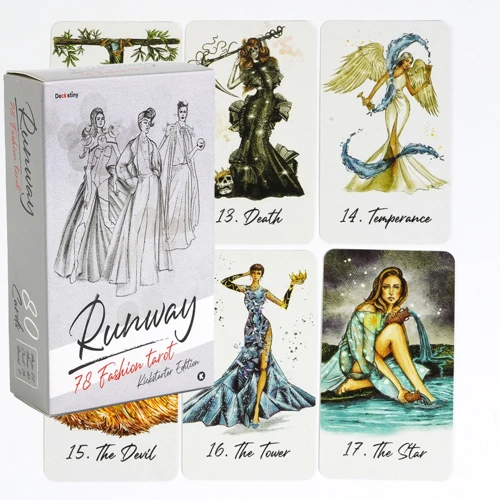
1. Tarot-inspired Clothing and Accessories
Tarot-inspired clothing and accessories have become a popular trend in the fashion world, reflecting the mystical and spiritual appeal of tarot reading. Designers and brands have incorporated tarot symbolism into their collections, creating garments and accessories adorned with tarot card imagery, mystical symbols, and celestial motifs. Tarot-inspired clothing often features bold and intricate designs, capturing the essence of the cards’ archetypal energy. This fashion trend has gained momentum among individuals who resonate with the tarot’s mystical meanings and seek to express their connection to spirituality and self-discovery through their personal style. Tarot-themed apparel ranges from t-shirts and dresses to scarves and jewelry, allowing people to infuse their everyday outfits with a touch of enchantment. Whether it’s a t-shirt emblazoned with a tarot card illustration or a necklace featuring a tarot-inspired pendant, these fashion choices enable individuals to express their interest in divination and the mystical arts. This fashion movement not only serves as a visual representation of personal beliefs but also adds an element of intrigue and mystique to the wearer’s overall aesthetic. By incorporating tarot symbolism into their clothing and accessories, individuals can carry a piece of the mystical world with them and embrace the enchantment in their daily lives. The impact of tarot reading on modern witchcraft can also be seen in the fashion choices of those who practice witchcraft, as they often incorporate tarot-inspired elements into their magical attire. This fusion of fashion and spirituality signifies the powerful influence that tarot reading has on contemporary culture and personal expression. With the evolution of tarot reading in the digital age, individuals can not only seek guidance from tarot cards but also showcase their affinity for divination and self-discovery through their fashion choices. To explore more on the evolution of tarot reading in the digital age, click here evolution of tarot reading in the digital age.
2. Tarot-inspired Art Exhibits
Tarot-inspired art exhibits have become a captivating way for artists to express their fascination with the mystical world of tarot. These exhibits showcase diverse interpretations of tarot symbolism, allowing viewers to immerse themselves in a visually captivating experience. Artists often incorporate tarot cards, imagery, and themes into their works to evoke introspection and provoke thought. Such exhibits explore the rich symbolism of tarot through a variety of mediums, including paintings, sculptures, installations, and mixed media. They offer a unique opportunity to delve into the archetypal energies depicted in the tarot deck and reflect on their personal meanings and significance. Some notable tarot-inspired art exhibits have delved deep into the connection between tarot reading and modern witchcraft, exploring the intersection of spirituality and creativity. These exhibits serve as a platform for artists to delve into the mystical realms of tarot and present their interpretations to a wider audience. The impact of tarot reading on modern witchcraft has spurred a resurgence of interest in tarot-inspired art, as artists strive to capture the essence of divination and the enigmatic allure of the tarot in their creations.
Tarot Reading in Literature
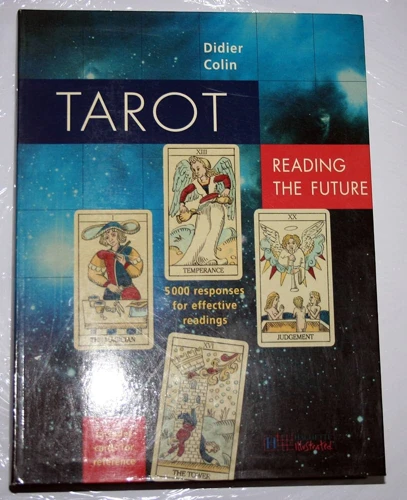
Tarot reading has left an indelible mark on the realm of literature, captivating writers and readers alike with its mystical allure. The tarot deck, with its rich symbolism and evocative imagery, has inspired numerous works of fiction and poetry. Many authors have incorporated tarot-themed storylines and characters into their works, adding an element of intrigue and mystery. Some novels revolve entirely around tarot, exploring its transformative power and the secrets it unveils to those who seek its wisdom. In poetry, tarot symbolism often serves as a metaphorical language, allowing poets to delve into introspection and explore themes of fate, intuition, and self-discovery. Tarot cards have also appeared in classic literature, adding a touch of the occult to iconic works. From modern tales to timeless classics, the influence of tarot reading in literature is a testament to its enduring presence and its ability to captivate the human imagination.
1. Tarot-themed Novels and Poetry
Tarot symbolism has weaved its way into the fabric of literature, captivating authors and poets with its mystical appeal. Numerous novels and poetry collections have embraced the themes of tarot cards, incorporating their imagery and meanings into captivating narratives and verses. One notable example is “The Night Circus” by Erin Morgenstern, where the tarot serves as a central element, guiding the characters’ destinies and propelling the plot forward. Another tarot-inspired work is “The Waste Land” by T.S. Eliot, a modernist poem that references the tarot card “The Hanged Man” as a symbol of spiritual transformation and sacrifice. These literary creations not only illuminate the ancient wisdom of tarot but also provide a rich tapestry of imagination and storytelling. They allow readers to explore the depths of the human experience and contemplate the interconnectedness of life, fate, and the power of choice. The impact of tarot reading on modern witchcraft further fuels the inspiration for tarot-themed literature, bridging the realms of the occult and literature in captivating ways.
2. Tarot Symbolism in Classic Literature
Classic literature has often embraced the mystical and symbolic power of tarot reading, weaving its imagery into the narratives of renowned works. One notable example is found in “The Hanged Man” in Victor Hugo’s novel, “The Hunchback of Notre-Dame,” where the character Gringoire encounters a towering representation of the tarot card. The Hanged Man is traditionally seen as a symbol of sacrifice and surrender, and in this context, it serves as a foreshadowing of Gringoire’s own trials and tribulations in the story. In another famous novel, “Alice’s Adventures in Wonderland” by Lewis Carroll, tarot elements are subtly incorporated. The Queen of Hearts and her courtiers, for instance, mirror the imagery associated with the suit of Cups in the tarot deck, symbolizing emotions, intuition, and relationships. Additionally, the Mad Hatter’s never-ending tea party may hint at the concept of timeless cycles, reminiscent of the Wheel of Fortune. The use of tarot symbolism in classic literature adds depth and mystery to these beloved stories, inviting readers to explore deeper meanings within the text. These subtle nods to tarot continue to capture the imagination of literary enthusiasts, bringing the ancient practice into the realm of the written word and captivating readers with its timeless allure. For more on the influence of tarot reading in modern witchcraft, see our article on the subject.
Tarot reading has found a new home in the realm of social media, captivating audiences and creating communities of enthusiasts. Platforms like Instagram and TikTok have become virtual spaces where tarot readers share their interpretations and insights. In fact, Instagram has seen the rise of tarot readers who provide daily card readings, advice, and spiritual guidance to their followers. These readers often use visually appealing imagery and captivating captions to engage their audience. On TikTok, users have embraced tarot challenges, where they showcase their card readings in creative and entertaining ways. Tarot-related hashtags have also become popular, allowing users to explore different perspectives and connect with fellow tarot enthusiasts. The accessibility and interactivity of social media have given tarot reading a modern twist, making it more accessible than ever before. Whether it’s through daily readings, challenges, or hashtags, social media has become a vibrant platform for those seeking guidance and connection through the mystical world of tarot.
1. Tarot Readers on Instagram and TikTok
Tarot reading has found its place in the world of social media, particularly on platforms like Instagram and TikTok. Tarot readers have created dedicated accounts to share their insights, interpretations, and readings with a global audience. These platforms offer a convenient and accessible way for individuals to seek guidance and connect with the mystical world of tarot. Many tarot readers on Instagram and TikTok provide free daily card readings, advice on love and relationships, and tips for personal growth. They often incorporate visually appealing images of tarot decks, crystals, and other mystical elements to enhance the experience. Additionally, some tarot readers offer personalized readings through direct messages or live video sessions. As these platforms continue to gain popularity, the community of tarot enthusiasts has grown exponentially, fostering a vibrant online community where individuals can share their experiences, learn from one another, and explore the fascinating realm of tarot. So if you’re looking for guidance or simply curious about the mystical world of tarot, Instagram and TikTok are fantastic platforms to discover talented and insightful tarot readers.
Tarot reading has found a vibrant and engaging community on social media platforms, particularly on Instagram and TikTok. These platforms offer a space for tarot enthusiasts and readers to share their knowledge, insights, and interpretations with a wider audience. One popular trend that has emerged is the creation of tarot challenges, where participants are given daily prompts to draw and interpret a card from their tarot deck. These challenges not only enhance the skills of tarot readers but also encourage a sense of community and connection among the participants. Hashtags such as #TarotChallenge and #TarotCommunity allow users to discover and engage with a wide range of tarot-related content. Additionally, these platforms provide an opportunity for tarot readers to offer digital readings and connect with clients from all over the world. The widespread availability and accessibility of tarot content through social media have contributed to the continued growth and popularity of tarot reading in pop culture.
Conclusion
The rise of tarot reading in pop culture speaks to its timeless appeal and the profound impact it has had on various forms of entertainment, fashion, art, literature, and social media. Through its portrayal in movies and TV shows, tarot cards have captured the imagination of audiences, influencing plotlines and serving as symbols of character traits. In music, tarot reading has inspired lyrics, album artwork, and a sense of mysticism. The fashion world has embraced tarot symbolism, with designers incorporating tarot-inspired clothing and accessories into their collections. Art exhibits showcasing tarot-inspired works have captivated audiences with their evocative imagery. In literature, tarot-themed novels and poetry have explored the intricacies of human nature and the pursuit of self-discovery. Social media platforms have become a hub for tarot readers, as they share their insights and engage in tarot challenges and hashtags. The origins of tarot reading can be traced back centuries, yet its timeless appeal continues to captivate individuals seeking guidance, introspection, and a connection to the mystical. The influence of tarot reading in pop culture is a testament to its enduring power and its ability to resonate with people from all walks of life, transcending time and spreading its enchantment across generations.
Frequently Asked Questions
1. What is the purpose of tarot reading?
Tarot reading is often used as a tool for self-reflection, introspection, and gaining insights into various aspects of life. It can provide guidance, clarity, and inspiration to individuals seeking answers to their questions or seeking a deeper understanding of themselves and their life path.
2. Is tarot reading a form of fortune-telling?
While tarot reading is often associated with predicting the future, it is important to note that it is not a definitive method of fortune-telling. Instead, tarot cards serve as a symbolic tool that can help individuals explore possibilities, gain perspective, and make informed decisions based on the intuitive interpretations of the cards.
3. Can anyone learn to read tarot cards?
Yes, anyone can learn to read tarot cards with dedication, practice, and a willingness to delve into the symbolism and meanings associated with each card. It is essential to develop a deep understanding of the cards, their meanings, and how to interpret their placement within different tarot spreads.
4. What is the significance of the Major Arcana in tarot reading?
The Major Arcana consists of 22 cards that represent significant life events, archetypal energies, and transformative experiences. These cards hold a powerful symbolic and spiritual meaning, carrying messages and lessons that can guide individuals through important stages of personal growth, self-discovery, and transformation.
5. Can tarot reading provide definitive answers?
Tarot reading does not provide definitive answers but offers insights and perspectives that can help individuals gain a better understanding of their situation. The interpretation of tarot cards relies on the reader’s intuition and the context of the reading, allowing for multiple interpretations and possibilities.
6. Is tarot reading associated with any specific religious beliefs?
Tarot reading is not tied to any specific religious beliefs. It is a flexible practice that can be embraced by individuals of various spiritual paths or those who do not follow any specific religious doctrine. Tarot taps into universal archetypes, making it accessible to people from different backgrounds.
Tarot cards do not possess the ability to reveal hidden secrets or specific information about future events. Instead, they serve as a tool for self-reflection and accessing one’s own intuition, helping individuals explore their own thoughts, emotions, and desires in a more profound and insightful way.
8. Are online tarot readings as accurate as in-person readings?
The accuracy of tarot readings, whether online or in-person, is subjective and depends on the individual reader’s skills, intuition, and connection with the cards. While online tarot readings can provide valuable insights and guidance, some individuals may prefer the intimate and personal experience of an in-person reading.
9. Can tarot cards be used for manifestation or setting intentions?
Yes, tarot cards can be incorporated into manifestation or intention-setting practices. By selecting cards that represent desired outcomes or qualities, individuals can use the symbolism and energy of the cards to focus their intentions and align their actions with their goals.
10. How can one find a reliable tarot reader?
When seeking a reliable tarot reader, it is important to look for individuals with experience, knowledge, and a deep understanding of the cards. Reading reviews, seeking recommendations, and personally connecting with the reader’s style and approach can help ensure a positive and meaningful tarot reading experience.






